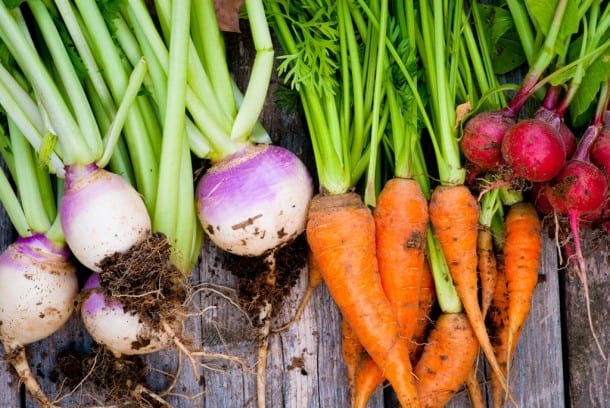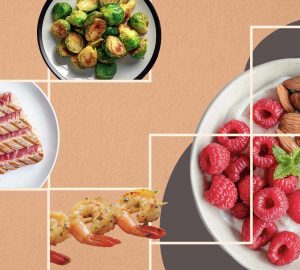It’s that time of year when most root vegetable crops are harvested so therefore, I thought it would be appropriate to give them some attention to see how you can add these nutrition powerhouses to your diet. Root vegetables, or tubers, are some of the most nutrient-dense vegetables in the world, and we’re lucky in Edmonton to have good year-round access to many varieties. Many root vegetables, such as daikon, horseradish, kohlrabi, radishes, rutabaga, and turnip are also classified as cruciferous vegetables, which have their own set of nutritional benefits. When it comes to the nutritional profile of root vegetables, while often being sold at relatively low prices, they certainly offer very good value for your dollar.
In general, root vegetables have experienced decreasing popularity over the last few decades in western societies, especially with the younger generations. Two of the biggest factors influencing this are the increased popularity of processed or convenience foods, and the somewhat unsightly, stodgy reputation of root vegetables as a whole.
All of the following are classified as root vegetables:
- Yams Beets Parsnips
- Turnips Rutabagas Carrots
- Yuca Kohlrabi Onions
- Garlic Celery root Horseradish
- Daikon Turmeric Jicama
- Radishes Ginger Jerusalem artichokes
Grown in the ground, they absorb many nutrients from the soil, but this means they can also absorb harmful substances from ground water such as pesticides, so choosing organic varieties may be preferable. While they share many of the same characteristics, such as being high in antioxidants, Vitamins A, B, C, and iron, and comprised of slow-burning carbohydrates and lots of fibre, each one wears its own cape as far as nutritional superpowers go. They’re relatively low in calories in relation to satiety (feeling full), making them good dietary additions for weight loss and weight maintenance. The type of carbohydrate in most root vegetables is low-glycemic, meaning there’s a delayed blood glucose response, or better regulation of blood sugar. This is partially due to excellent fibre content, which also assists with digestion and excretion of waste.
It would only be prudent to discuss the almighty potato first. What a truly controversial vegetable! While the most well-known and versatile of all root vegetables, the debate rests on the high amounts of starch found in potatoes, which results in a high-glycemic response. While there are definitely problems with consuming potatoes in large quantities, they are considered a valuable post-workout recovery food due to how quickly glucose is released into the body, replenishing depleted glycogen storage levels in the muscles.
Moving on, most of us are familiar with the more common roots such as sweet potatoes & yams (different but often interchangeable), beets, carrots, garlic, and onions. Today’s focus will be on some of the less popular roots and tubers, with hopes that you may find yourself considering adding them to your repertoire.
- Turnips and Rutabagas – look similar to each other, with rutabaga being the larger and harder of the two. Both are members of the cruciferous vegetable family. They offer high fibre for very low calories, and good levels of calcium, phosphorous, potassium, and vitamin C. While turnips are subtle in flavour and lend themselves to cooking with more strongly-flavoured vegetables, rutabagas taste a bit more earthy and are best when pureed or mashed. Best use: Peeled, then mashed, pureed, roasted, or added to stews or curries. Also see the recipe at the end of this article, it’s one that turned me into a turnip lover!
2. Jicama – pronounced “hee-kuh-muh”, jicama is also quite low in calories, and is known for its sweet, white flesh and crunchy texture. Jicama is rich in vitamin C and contains anti-oxidants. Best use: replace a standard green salad with raw peeled, julienne-sliced pieces mixed with chopped cucumber, fresh lime juice, spices, and a pinch of salt. Also see the recipe at the end of the article that combines jicama with another root vegetable in a salad!
3. Celery root (a.k.a. Celeriac) – a member of the celery and carrot family with a taste similar to a blend of celery and parsley; only its root is used in cooking. It’s a great source of soluble fibre that aids digestion and helps to lower LDL (bad) cholesterol, and is also a good source of protein. Celeriac contains high levels of potassium and good levels of phosphorous and vitamin C. This root vegetable is notably most nutritious in its raw form, although it can be cooked as well. Best use: peeled and grated raw and mixed with chopped or sliced apples, walnuts, and drizzled with an apple cider vinegar-based dressing.
4. Jerusalem artichokes – less readily available, and not really an artichoke at all, Jerusalem artichokes (also known as sunchokes) vaguely resemble ginger root in appearance and contain large amounts of the carbohydrate inulin, a low-glycemic soluble fibre. Inulin is beneficial in the diet because it isn’t digestible and passes into the large intestine where it serves as a prebiotic, or food for healthy bacteria to eat. Best use: scrub well but don’t peel. Steam whole for about 15 minutes and rinse in cold water. Slice in 1/2″ slices. Best served at room temperature with a garlic mayonnaise, or see the recipe at the end of the article.
5. Turmeric root – is a member of the ginger family. Turmeric root looks looks similar to ginger root but is usually thinner and has orange flesh under the skin. Turmeric in its fresh and powdered spice form is becoming very popular for its high curcumin levels. Curcuminoids have been studied for their health benefits, and may include anti-inflammatory, anti-flatulent, anti-microbial, anti-tumour, and anti-arthritic properties, to name a few. In addition, turmeric root is a rich source of vitamins such as B6, choline, niacin, riboflavin, vitamin C, and minerals like calcium, iron, potassium, manganese, copper, zinc, and magnesium. With all of these characteristics considered, it’s no wonder that it has one of the highest anti-oxidant strengths (total-ORAC value) among the herb and spice species. Best uses: wearing gloves due the propensity to stain skin and porous surfaces, peel and grate like ginger root to add to soups, salads, stir-frys, dressings, and smoothies. Can also add grated turmeric when cooking rice to give it a nice golden colour.
I hope you’ve seen something here that piques your interest in this fall harvest of roots and tubers. After-all, it’s fun to try different foods, and eating a variety of foods ensures that you receive a wide array of necessary nutrients. Furthermore, if you can do that with budget-friendly, satisfying root vegetables, then why not?
Recipes
Roasted Radishes
Roasting radishes mellows the spicy flavour and turns them into slightly crunchy, delectable morsels. Lemon and salt are the easiest ways to season roasted radishes, but adding chopped garlic, parsley, and/or anchovy will increase the flavour. Works well as an appetizer with toothpicks or as a side dish. Serves 4-6.
Ingredients:
3 bunches of radishes
1/4 cup olive oil
1/4 tsp ground black pepper
1/4 tsp salt
juice of 1 lemon
Directions: Preheat oven to 475 degrees. Cut leaves and stems off radishes. Slice smaller radishes in halves and larger ones into thirds or quarters. Place in a rimmed baking pan and cover with a light drizzle of olive oil, salt, and pepper. Bake 15-20 minutes, stirring once or twice. Finish with lemon juice to taste and an additional sprinkle of salt, if desired.
Skirt Steak and Turnip Risotto
This Primal version of risotto cooks a lot faster than the traditional rice version, and eliminates a lot of carbs by using grated turnip instead. The flavour is mild with a bit of earthiness and the texture is soft and comforting – perfect for a chilly winter night. Serves 4.
Ingredients:
2 cups chicken stock 1 shallot
3-4 large turnips (8 cups grated) 1/4 cup oil
2 tbsp unsalted butter 1/4 cup fresh herbs for garnish, finely chopped
1 lb skirt steak or pork chop (with fat)
Directions:
In a small pot, bring the chicken stock to a boil. Peel the turnips and grate in a food processor or with a box grater. In a large pot, melt the butter at medium-high heat. Add the grated turnip and stir. Add the chicken stock and keep at a rapid boil, stirring occasionally, for 10-12 minutes. While the turnips are cooking, slice the steak or pork chop into thin strips and lightly season with salt and pepper. Heat a tbsp of oil in a skillet over high heat. When the skillet is very hot, add the meat and cook until it reaches desired doneness. Remove from pan. Peel the shallot and slice very thinly. Heat 2 tbsp of oil in the pan with the drippings; you’ll know it’s hot enough if you drop a little shallot in and it begins to sizzle immediately. Add the remaining shallot and brown for about one minute until it’s nice and crispy, but not burnt. Stir the cooked meat and fresh herbs into the cooked grated turnip. Garnish with crispy shallot.
Jicama Sunchoke (Jerusalem Artichoke) Salad with Honey Mustard Dressing
Jicama, Jerusalem artichokes, red kidney beans, mixed baby greens, onions, and sweet bell peppers make a fabulous salad with homemade honey mustard dressing. Allow 1 hour of marinating time before serving. Serves 3-5.
Ingredients for Salad:
1 lb jicama, peeled, julienned
1 cup unpeeled Jerusalem artichokes, thinly sliced
3/4 cup red kidney beans, cooked
1 container organic mixed baby greens
1/2 green bell pepper, julienned
1/2 yellow bell pepper, julienned
1/2 red bell pepper, julienned
3 green onions, coarsely chopped
Ingredients for Dressing:
1/4 cup apple cider vinegar
1/4 cup raw honey
1/4 cup Dijon mustard
1-2 cloves garlic, minced
1/2 cup sunflower seed oil*
1-2 tbsp fresh minced parsley
1 tbsp fresh minced dill
1 tsp – 1 tbsp fresh minced cilantro salt and pepper to taste
Directions:
Make the dressing – Combine all dressing ingredients in a small bowl and whisk together. Set aside. *other options for oil include olive oil, avocado oil, or hazelnut oil
Make the salad – Combine all salad ingredients in a large bowl. Toss well with salad dressing and allow to marinate at room temperature for at least an hour. Toss again before serving.
Author Bio
Randi Hawley has a passion for health, wellness, fitness, and strong communities. She follows a path of continuous learning and self-improvement and gets great joy out of sharing her knowledge and enthusiasm with others.









1 Comment